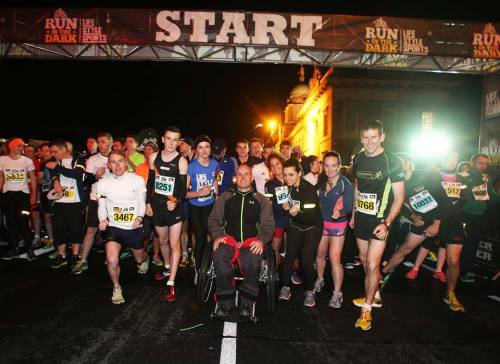Last Saturday morning I woke up, facing into my seventh and eighth training sessions in four days and I struggled. As my care assistant knocked the door, let himself in and made his way up the stairs in my house, I wanted to tell him to turn around and let me sleep on.
I want to write this blog to tell you that I can only do what I do because of people and the strategies that they help me to keep in place. Good people. It made me think of all of you who are part of Run in the Dark: training, struggling with training, fundraising, volunteering and setting up pop-ups. I suspect that the good people around you are as important to you as they are to me. Whether it’s a running partner or someone to watch your kids when you’re training or a good physiotherapist. We need more than just us to get where we want to go. It’s the only way. I am sure of it.
So, when last Saturday, my care assistant knocked the door, let himself in and made his way up the stairs in my house and I wanted to tell him to turn around and to let me sleep on, (not because I am lazy or just don’t fancy it, but because it’s hard and I’m tired and eight sessions in four days is a tough schedule with work and life and all it involves), I said nothing. And this was only because I knew that in 90 minutes time Simon O’Donnell, my South Pole teammate turned rehab teammate would be waiting in the gym to help me train and Dr. Neil Fleming, the post-doctoral research fellow that we fund, would be ready to capture the data.
My care assistant, Chris came into my room, I transferred onto my shower chair and rolled into the shower. He got my clothes, I dressed and we headed to the lab. Simon, Neil, Chris and I together completed 30 minutes of standing me at a squat rack completing single knee bends, alternate knee bends, double leg straightens and squats.
Then I completed my usual hour of spinal electrical stimulation while walking in my robot.
The reason I am doing it is clear to me – I want and have a shot at treating, if not curing my and others paralysis. I am the only person in the world so far who’s fortunate enough to trial this combination of electrical stimulation, drug and walking. But even when the future benefit is clear, my present self (the tired self who wants to sleep) trumps the future self (the paralysed man who is getting some way better). Even where there can be no clearer incentive for me to commit to every training session, I need strategies and good people to guard against my present self failing. People I cannot and will not let down.
So, now, at the end of another day with an early morning in the gym tomorrow, I think about that Run In The Dark red river of light that will flow through the streets on Wednesday the 11th of November carrying me along with it (www.runinthedark.org). I think about the 25,000 people right around the world pulling on running shoes and going training and how you’ve helped me to get out of bed, to go to the lab. Over the last few years I’ve met so many people with different reasons for running: some run in the dark as first timers with the aim of finishing, some are there to win, some are there for their loved ones who are injured and so many are there to help us fast-track a cure for paralysis, to be on this most exciting of expeditions. Runners, walkers, volunteers, committees, professionals and sponsors, look after yourselves, get help and support from others to do so, and know that I couldn’t do this without you.


